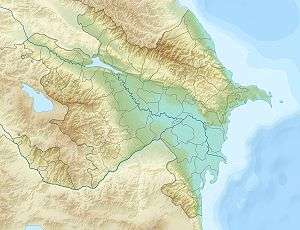Gobustan National Park
Gobustan State Reserve located west of the settlement of Gobustan, about 40 miles (64 km) southwest of the centre of Baku was established in 1966 when the region was declared as a national historical landmark of Azerbaijan in an attempt to preserve the ancient carvings, mud volcanoes and gas-stones in the region.
| UNESCO World Heritage Site | |
|---|---|
 Entrance to the Gobustan Rock Art Cultural Landscape Reserve | |
| Location | Azerbaijan |
| Includes |
|
| Criteria | Cultural: (iii) |
| Reference | 1076rev |
| Inscription | 2007 (31st session) |
| Area | 537.22 ha (1,327.5 acres) |
| Buffer zone | 3,096.34 ha (7,651.2 acres) |
| Coordinates | 40°7′30″N 49°22′30″E |
 Location of Gobustan National Park in Azerbaijan | |
Gobustan State Reserve is very rich in archeological monuments, the reserve has more than 6,000 rock carvings, which depict people, animals, battle-pieces, ritual dances, bullfights, boats with armed oarsmen, warriors with lances in their hands, camel caravans, pictures of sun and stars, on the average dating back to 5,000-20,000 years.
Gobustan State Historical and Cultural Reserve acquired national status in 2006. As a part of the 31st Session of the UNESCO World Legacy Committee held in Christchurch, New Zealand on June 23 - July 2, 2007 included within the World Social Legacy List.[1]
Prehistoric carvings
The rock carvings and petroglyphs at the site display mesmerizing images of prehistoric life in the Caucasus. The well-preserved sketches display ancient populations travelling on reed boats; men hunting antelope and wild bulls, and women dancing. [2] The famed Norwegian anthropologist Thor Heyerdahl returned many times to Azerbaijan between 1961 and his death in 2002 to study the site in his "Search for Odin".
The language of the ancient population of Gobustan is disputed, but the petroglyphs still give information about the lives of prehistoric people who lived there. More than 4,000 pictures of animals, humans, natural life experiences, hunting, and dancing were carved over a span of thousands of years. Most of the petroglyphs are on large cliffs, divided among multiple ancient residences, and in some cases they have been carved over older images. The first carvings depicted natural human and animal figures, often irregularly, but over time they began to more closely resemble the measurements and proportions of their subjects, including such details as the foot muscles of people in hunting scenes. The heads of the human figures tend to be small and carved without noses, mouths, eyes, or ears. However, experts do not interpret this lack of facial features as an indication that the Gobustan artists lacked technical skill, since some of the carvings demonstrate a higher degree of complexity and detail. Many scenes from tribal life are depicted among the petroglyphs, and images from the Seven Beauties cave suggest that women may have participated in hunting. [3][4][5]
Mud volcanoes
It's estimated that 300 of the planet's estimated 700 mud volcanoes sit in Gobustan, Azerbaijan and the Caspian Sea.[6] Many geologists as well as locals and international mud tourists trek to such places as the Firuz Crater, Gobustan, Salyan and end up happily covered in mud which is thought to have medicinal qualities.
Flora and fauna
The nature of Gobustan is much more suitable than other regions of Azerbaijan. However, the natural conditions of these places were completely different in 20-25 thousand years ago. From the drawings of animals and human figures on the Gobustan, rocks seem to have been under warm climate from 10 to 12 thousand years. People were wearing gentle clothes, men tightened their paws, and women were wearing short leather dresses. Because of the permanent hot weather, greenery and abundant water, these places were the habitats of wild animals: bulls, horses, deer, goats, and other animals lived in Gobustan. From the rock drawings and the archeological findings, wolves, tigers, foxes, jackals and other wild animals have been found in this place in ancient times. In 1968 while cutting off 3 metres (9.8 ft) depth stone layer near Atbulakh, accidentally the large bones of an unknown animal were cut off. The workers informed the Ministry of Culture of the Azerbaijan SSR, not knowing what those bones were. After the investigation of the discovered bones, it was determined that these bones were the VI bone of the neck of the southern elephant, which lived in Gobustan. [5][7]
Gaval Dash
The Gaval Dash is a natural musical stone which can only be found in Gobustan, Azerbaijan. Among the stone books there are a big flat stone formed out of 3 supports. Suffice it to touch the object with a small stone, musical sounds come from it. The stone is called Gaval Dash, the sound can be compared with a tambourine. The Gaval Dash have been formed due the combination of unique climate, oil and gas which can be found in the region of Azerbaijan. [4]
External links
- Gobustan from "Window to Baku"
- The Rock Engravings of Gobustan from a site devoted to Jean Auel's books.
- Archaeoastronomy relating the petroglyphs to other ancient carvings and the theories of Thor Heyerdahl
See also
- Nature of Azerbaijan
- National Parks of Azerbaijan
- State Reserves of Azerbaijan
- State Game Reserves of Azerbaijan
- Zoroastrianism in Azerbaijan
- Gobustan District
- Ramana, Azerbaijan
- Khinalyg
- Yanar Dag
- Fire Temple of Baku
References
- "Gobustan State Historical-Artistic Reserve".
- "Early Man in Azerbaijan When Ancient Stones Speak by Ronnie Gallagher and Abbas Islamov". www.azer.com. Retrieved 2018-09-26.
- "Qobustan". unesco.mfa.gov.az. Retrieved 2018-09-26.
- "ГАВАЛДАШ" (PDF).
- "Духовный Мир Конных И Лодочных Охотников Эпохи Бронзы Азербайджана" (PDF).
- "Mud Volcanoes - Mysterious Phenomena Fascinate Scientists and Tourists by Ronnie Gallagher". www.azer.com. Retrieved 2018-09-26.
- "Петроглифы Гобустана".